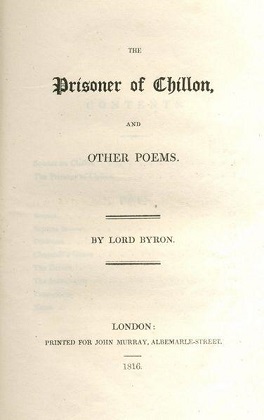The Prisoner of Chillon on:
[Wikipedia]
[Google]
[Amazon]
 ''The Prisoner of Chillon'' is a 392-line narrative poem by
''The Prisoner of Chillon'' is a 392-line narrative poem by
 The work's themes and images follow those of a typical poem by Lord Byron: the protagonist is an isolated figure, and brings a strong will to bear against great sufferings. He seeks solace in the beauty of nature (especially in sections ten and thirteen), and is a martyr of sorts to the cause of liberty. Like much of Byron's work, it came about as a reaction to his own experiences as a traveller, making use of historical and geographical knowledge Byron gained in continental Europe.
Byron titled his work ''The Prisoner of Chillon: a fable''; stylistically, it is a romantic verse-tale.
The work's themes and images follow those of a typical poem by Lord Byron: the protagonist is an isolated figure, and brings a strong will to bear against great sufferings. He seeks solace in the beauty of nature (especially in sections ten and thirteen), and is a martyr of sorts to the cause of liberty. Like much of Byron's work, it came about as a reaction to his own experiences as a traveller, making use of historical and geographical knowledge Byron gained in continental Europe.
Byron titled his work ''The Prisoner of Chillon: a fable''; stylistically, it is a romantic verse-tale.
''The Prisoner of Chillon'', 1816 first edition.
{{DEFAULTSORT:Prisoner of Chillon, The Poetry by Lord Byron 1816 poems John Murray (publishing house) books 1816 books
 ''The Prisoner of Chillon'' is a 392-line narrative poem by
''The Prisoner of Chillon'' is a 392-line narrative poem by Lord Byron
George Gordon Byron, 6th Baron Byron (22 January 1788 – 19 April 1824), known simply as Lord Byron, was an English romantic poet and peer. He was one of the leading figures of the Romantic movement, and has been regarded as among the ...
. Written in 1816, it chronicles the imprisonment of a Genevois monk, François Bonivard, from 1532 to 1536.
Writing and publication
On 22 June 1816, Lord Byron and his contemporary and friend Percy Bysshe Shelley were sailing onLake Geneva
, image = Lake Geneva by Sentinel-2.jpg
, caption = Satellite image
, image_bathymetry =
, caption_bathymetry =
, location = Switzerland, France
, coords =
, lake_type = Glacial lak ...
(referred to as "Lac Leman", the French
French (french: français(e), link=no) may refer to:
* Something of, from, or related to France
** French language, which originated in France, and its various dialects and accents
** French people, a nation and ethnic group identified with Franc ...
name, throughout the poem) and stopped to visit the Château de Chillon
Chillon Castle (french: Château de Chillon) is an island castle located on Lake Geneva, south of Veytaux in the canton of Vaud. It is situated at the eastern end of the lake, on the narrow shore between Montreux and Villeneuve, which gives acce ...
. After touring the castle (and walking through the dungeon in which Bonivard was imprisoned), Byron was inspired by Bonivard's story and composed '' The Sonnet of Chillon''.
Because of torrential rainfall, Byron and his companion rested at a hotel in Ouchy
Ouchy is a port and a popular lakeside resort south of the centre of Lausanne in Switzerland, at the edge of Lake Geneva (french: lac Léman).
Facilities
Very popular with tourists for the views of nearby France ( Évian-les-Bains, Thonon ...
following their tour. In late June or early July (several early drafts and copies present conflicting dates), Byron composed the longer fable. The work was probably completed by 2 July 1816. ''The Prisoner of Chillon'' was first published as ''The Prisoner of Chillon and Other Poems'' by John Murray on 5 December 1816.
Structure
 The work's themes and images follow those of a typical poem by Lord Byron: the protagonist is an isolated figure, and brings a strong will to bear against great sufferings. He seeks solace in the beauty of nature (especially in sections ten and thirteen), and is a martyr of sorts to the cause of liberty. Like much of Byron's work, it came about as a reaction to his own experiences as a traveller, making use of historical and geographical knowledge Byron gained in continental Europe.
Byron titled his work ''The Prisoner of Chillon: a fable''; stylistically, it is a romantic verse-tale.
The work's themes and images follow those of a typical poem by Lord Byron: the protagonist is an isolated figure, and brings a strong will to bear against great sufferings. He seeks solace in the beauty of nature (especially in sections ten and thirteen), and is a martyr of sorts to the cause of liberty. Like much of Byron's work, it came about as a reaction to his own experiences as a traveller, making use of historical and geographical knowledge Byron gained in continental Europe.
Byron titled his work ''The Prisoner of Chillon: a fable''; stylistically, it is a romantic verse-tale.
Concept
The poem describes the trials of a lone survivor of a family who have been martyred. The character's father was burnt at the stake, and out of six brothers, two fell at the battlefield while one was burnt to death. The remaining three were sent to the castle of Chillon as prisoners, out of which two more died due to pining away. In time only the narrator lived.References
External links
*''The Prisoner of Chillon'', 1816 first edition.
{{DEFAULTSORT:Prisoner of Chillon, The Poetry by Lord Byron 1816 poems John Murray (publishing house) books 1816 books